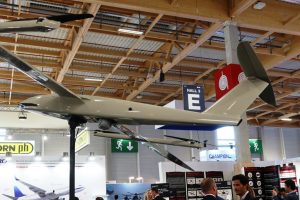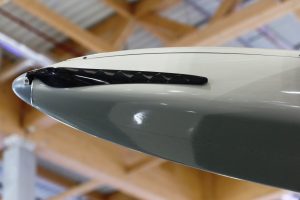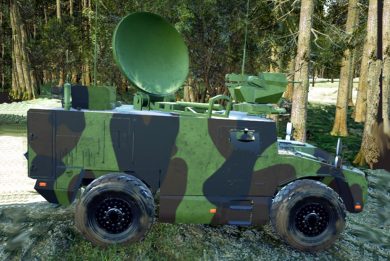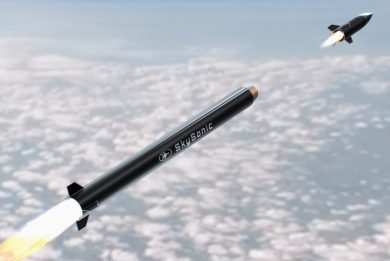
PAS 2023 – The French Defence Innovation Agency assigns to Nexter Arrowtech, EOS Technologie and Traak a development contract for the Larinae remotely operated munition project
On Friday, June 16th, three days before the inauguration of the 54th edition of the Paris Air Show, the French AID (Agence Innovation Défense, or Defence Innovation Agency) assigned to a team of companies made by Nexter Arrowtech, part of KNDS, EOS Technologie and Traak, a development contract for a remotely operated munition.
France launched a gap-filler programme to acquire Switchblade loitering munitions from the United States, however the French Ministry of the Armed Forces aim is to provide its forces with a sovereign system, fully developed and produced in France.
Hence the launch of the Larinae call for projects which aimed at providing the Armée de Terre, the French land forces, with a medium-range antitank weapon, defined as a “ remotely operated munition ”. EDR On-Line understood the system will be of course a loitering munition, but will also be recoverable by parachute, and might even be used in a reconnaissance-only mode without the warhead, which makes it in fact a multi-mission tool.
The programme innovative approach included that the work would be conducted by a team including a major as well as small medium enterprises, that it should be innovative providing “something different” from what is already available on the market, and the third and key point is that the price would be fixed ahead of development, the new system needing that it can be easily produced, in line with the new war economy concept. Target price is 200,000 Euro, however the team aims to “do better”.

The proposed solution, illustrated on Day 1 of the Paris Air Show at a joint press conference by the three partner companies, in based on a n unmanned air vehicle (UAV) that is being designed by EOS Technologie, fitted with a GPS denied navigation system provided by Traak, and armed with an explosively formed penetrator, under development by Nexter Arrowtech.
The latter will generate an explosively formed penetrator (EFP), a solution that allows detonating the charge at a certain distance from the target, which is attacked from the top; albeit the Bourges-based company developed the submunitions of the Bonus 155 mm artillery munition, which also produce an EFP, EDR On-Line understood that the Larinae warhead is based on a different technology, no more information being provided. The munition will weight between 2 and 3 kilograms, the generated slug hitting the target at around 2,000 m/s. The aim is to have a reusable munition, should no target be attacked, therefore safety is a key issue when recovering a non-exploded system; to this end the warhead will indicate through a LED its status, green showing it is safe while red will require an EOD team to intervene.
A specialist in positioning, navigation and tracking solutions, Traak provides the system navigation solution, but here too not much data are available as the fight in the electronic warfare domain remains pretty classified. When closing to the target the operator will have positive control on the aircraft, the optronic package allowing him to close as much as possible on to the target with metric accuracy before activating the warhead.
What could be seen at the Paris Air Show was a model of what the future Larinae solution proposed by the three companies might look like, a model of an aircraft similar to it was exhibited in the EOS Technologie booth.
The airframe adopts some peculiar solutions, starting from the materiel used, which is composite without the use of carbonfibre, an innovative manufacturing process allowing producing very light and strong elements at a much lower price.
The airframe is quite conventional with an aerodynamically shaped fuselage with mid-wing and T-shaped tailplane. To reduce the logistic footprint the wings can be disassembled in four elements while the fuselage is made of two parts, the airframe fitting in a 1.45 metres long case, a second case hosting the ground control station.

Propulsion is provided by an electric motor fitted at the front, which operates a two-blade propeller. Another peculiarity comes from the propeller, which blades extend when the motor rotates while when the motor is cut they fold along the fuselage reducing drag. The airframe lift-to-drag ratio exceeds 30, which means it can be used as a glider to nil the acoustic signature.
Two pods can be located one under each wings; each one carries two rotors activated by electric motors, providing lift required for vertical take-off and landing. This allows the system to be operated from any surface without any add-on equipment. Contrary to most airframes adopting this solution, the pods do not contain batteries, power being provided by the main battery, a weight-saving solution according to EOS Technologies; this means that the wing elements have electric connectors to allow transferring power to the rotor motors. According to EOS Technologie in the final model VTOL pods will have a slightly different design in order to reduce their drag, a key feature especially when the airframe is used in glider mode. When VTOL is nit required the aircraft takes off with the use of a small catapult, a parachute allowing its recovery.

The warhead is located just behind the motor, the Lithium-Ion battery being installed close to the centre of gravity, the optronic gimbal being also located close to it. Fitted with day and night sensors, it allows detecting a vehicle at 15 km distance during the day and at 3 km by night. Once the target has been positively identified by the operator, the optronic system ensures the guidance of the aircraft to the target, also exploiting artificial intelligence algorithms. When diving towards the target the engine is stopped, blades folding automatically, the airplane increasing its speed from the standard 80 km/h of the cruise speed up to over 150 km/h.
Minimum required range is 50 km, however the design team is confident that the sytem will be capable to reach 80 km. While the main objective of French armed forces is to obtain a munition capable to destroy an armoured vehicle at range, the aircraft can also be used for intelligence, surveillance, and reconnaissance missions, and without the warhead load and the VTOL kit is should be capable to have a range in excess of 120 km.
With the contract signed in mid-June 2023, the prototype should be provided to the customer within 18 months, which puts the delivery date in late 2024. The prototype will be used to test different operating modes, the result of the Larinae programme being a remotely delivered munition that in some sort represents a new category of weapon.
Photos by P. Valpolini



